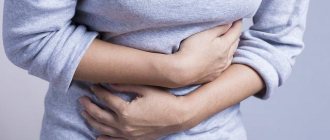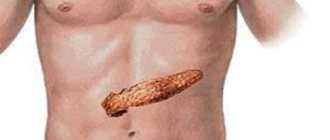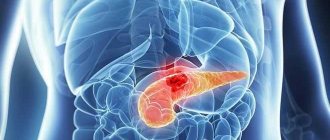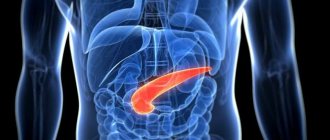Functions of the pancreas
In normal condition, the organ works for the benefit of the endocrine and exocrine systems of our body. The endocrine part regulates carbohydrate metabolism. The parenchyma has islets of Langerhans located in the tail. They contain cells that secrete glucose and glucagon into the bloodstream. These hormones have the opposite effect: glucagon increases blood sugar levels, and insulin decreases them.
The exocrine function is to produce pancreatic juice, which is necessary for the digestion of food in the duodenum. The organ secretes the following digestive enzymes:
- trypsin and chymotrypsin - are involved in the digestion of proteins;
- lactase and amylase - break down carbohydrates;
- lipase - breaks down fats that have already been exposed to bile.
In addition to enzymes, pancreatic juice includes components that neutralize aggressive gastric juice. This way it protects the intestinal mucosa from the effects of acid.
Where is the pancreas located in humans?
Already from the name it becomes clear that it is located in the stomach area. The organ weighs only 70-80 grams. Outwardly it looks like a long lobular element 16-23 cm long. The pancreas consists of three sections: head, body and tail.
The location of the body is behind the stomach, near the duodenum, which covers the gland, forming a horseshoe shape. The organ itself is combined with the duodenum by ducts and is adjacent to the back side of the stomach, and the tail is adjacent to the fornix of the stomach and the gates of the liver and spleen. If you show it on the stomach, the organ is located just above the navel (about 5 cm), on the left side under the ribs.
How the pancreas hurts: symptoms
The organ can process proteins, fats and carbohydrates only when it is healthy. If pathologies develop in it, the person begins to get sick, feeling tingling, heaviness, and other unpleasant symptoms.
How to find out what pain is in the pancreas
If something is wrong with the head, a person feels discomfort in the middle of the abdomen, which simultaneously radiates to the right rib or back. Despite the fact that the gland is located on the left, the inflammatory process of the head can cause pain on the right. If the body is affected, discomfort appears on the left side of the midline. With pathology of the tail region, the pain covers the left side of the abdomen above the navel.
Photo source: shutterstock.com
Let's consider the most common disorders that occur when the functions of the pancreas are impaired:
- pain in the upper abdominal cavity, left hypochondrium. Pain may appear after eating;
- constant nausea, vomiting;
- a sharp decrease in appetite;
- bloating and rumbling in the stomach (flatulence);
- bowel disorders. As a rule, diarrhea occurs, and undigested food and fat may be present in the stool;
- signs of intoxication - rapid heartbeat, increased fatigue, general weakness, sweating, headaches;
- increase in liver size;
- change in skin tone (becomes yellow), often in the area of the projection of the pancreas.
In this case, pain can occur day or night, after sexual intercourse, drinking coffee or sweets, from nerves, after poisoning, childbirth, etc. The cause of discomfort may be psychosomatics.
The most common signs of pathological changes in the pancreas are pain and indigestion. In women and men, symptoms are similar.
Why does the pancreas hurt?
The causes of the discomfort may be short-term, after which the pain stops. These factors include:
- binge eating;
- severe stress;
- large dose of alcohol;
- some medications.
But with the frequent appearance of these factors, the pathological process can become permanent and affect the anatomical and physiological characteristics. Also, risk factors causing pancreatic diseases are:
- poor nutrition, an abundance of fatty foods in the diet or periodic use of strict diets;
- chronic smoking or alcoholism;
- mechanical injury;
- violation of metabolic processes;
- diseases of the digestive system;
- cholelithiasis;
- the presence of parasitic or viral infections;
- age-related tissue destruction;
- hormone therapy;
- hereditary predisposition.
The gland reacts sensitively to a person’s emotional background, so long-term depression or constant strong feelings are a common cause of destructive processes. This pattern is especially clear in women.
What diseases does pain indicate?
Unpleasant symptoms vary depending on the specific pancreatic disease. List the most common ones:
- acute and chronic pancreatitis;
- development of benign and malignant tumors;
- diabetes;
- pancreatic necrosis.
If the pancreas hurts in a pregnant woman, this does not necessarily indicate the presence of a disease. Perhaps the fetus is simply putting pressure on her. But without consulting a doctor, you won’t be able to know this for sure.
Photo source: shutterstock.com
Pancreatitis
If a patient has acute pancreatitis (inflammation, which is often accompanied by edema syndrome), he feels a sharp tingling sensation - colic. The pain is often girdling and spreads to the upper abdomen, left side and lumbar region.
Pancreas cancer
From acute pancreatitis can develop into chronic. This stage of the disease is characterized by pain of somewhat lesser intensity. The danger of exacerbation of chronic pancreatitis lies in the occurrence of tumors, including cancer. With a malignant tumor, the patient loses appetite, pain occurs under the ribs, and the color of stool and urine changes. A sick person quickly loses weight and there is a hormonal imbalance.
Cyst
This pathology is characterized by aching pain when a person eats. The discomfort stops if you lean forward.
Diabetes
Type I diabetes mellitus is characterized by severe thirst, increased appetite, and frequent urge to urinate.
Causes of local growth of the pancreatic head
It was not possible to determine the direct factor that leads to cancer of the head of the pancreas, and the disease is still being studied.
Often the male gender is affected by the disease. In addition, there are a number of negative reasons that affect the enlargement of the head of the pancreas.
- Poor nutrition. Excessive consumption of fatty foods leads to the production of large amounts of cholecystokinin. If there is an excessive amount of this hormone, cell hyperplasia may occur.
- Chronic diseases, including pancreatitis. Stagnant, damaging juice can lead to the degeneration of benign tumors into malignant neoplasms.
- Gallbladder diseases provoke tumor formation. Unsafe diseases include chronic calculous cholecystitis, psychocholecystectomy symptom, and cholelithiasis.
- Smoking, excessive drinking.
alcohol abuse
Not least important in the development of malignant tumors is hereditary predisposition. Therefore, if relatives have this disease, the risk of occurrence increases. In addition, people who work in unfavorable conditions when pancreatitis occurs in pregnant women are at risk.
In this case, a formation on the head of the pancreas also happens:
- due to operations previously performed on the pancreas;
- long-term use of medications;
- abscesses;
- cysts with fluid - detected on ultrasound as an anechoic formation;
- pseudocyst - accumulated pancreatic juice and fragments of parenchyma, surrounded by fibrous tissue, which on sonography is visible in the head of the pancreas as a hypoechoic formation in the form of a shadow;
- clogging of the Wirsung canal with calcification.
Impairments in the functionality of internal organs cannot always be felt; some pathologies pass without symptoms.
In turn, when the head of the pancreas is affected, the disease often occurs without symptoms, but in other cases, the patient will encounter a number of manifestations.
Based on age and physical well-being, signs of the disease are:
- painful discomfort of varying strength, radiating to the left limb or to the back;
- a burning sensation in the upper part of the peritoneum, where the ribs diverge;
- the temperature increases, which is not amenable to antipyretic drugs;
- often there is an attack of nausea, which leads to vomiting;
- the intestines are emptied unstably - diarrhea gives way to constipation.
pancreas hurts
Additional symptoms of pancreatic head cancer include:
- weight will rapidly decrease to the point of anorexia;
- lack of desire to eat;
- belching;
- dry mouth;
- feeling of heaviness in the peritoneum;
- thirst.
Then the clinic changes. The formation of the head of the pancreas increases, and the growth of metastases in other organs and tissues is observed. The patient experiences signs of yellowing of the skin and mucous membranes, discoloration of feces, unbearable itching and dark urine. It happens that your nose bleeds, your head hurts and your heart beats faster.
Additionally, the pathology develops through the accumulation of fluid in the abdomen, blood clots occur in the veins of the legs, bleeding in the intestines, the functionality of the heart muscle is impaired, and splenic infarction.
When the gallbladder becomes inflamed, the patient develops heartburn and colitis.
Which doctor should I contact if my pancreas hurts?
Any disruption in the functioning of an organ is fraught with hidden danger and requires an integrated, comprehensive approach. Diagnosis and treatment of pancreatic diseases are dealt with by:
- therapists;
- gastroenterologists;
- surgeons;
- endocrinologists;
- oncologists.
Therefore, it is difficult to unambiguously answer the question of which specialist should be contacted first.
Photo source: shutterstock.com
Diagnosis of the pancreas
If the symptoms listed above are present, then you should not delay your visit to the doctor. The clinic will perform the following procedures:
1. Laboratory research:
- general and detailed blood test;
- assessment of the amount of pancreatic enzymes in blood serum;
- biochemical blood test for glucose levels, liver enzyme activity and bilirubin;
- urine amylase test;
- stool analysis for enzyme and fat levels.
2. Ultrasound examination, with the help of which the doctor:
- examine the abdominal cavity and its structure;
- determine the contours of the pancreas;
- will assess the degree of patency of the bile ducts, the presence or absence of stones in the gallbladder or ducts.
3. X-ray - carried out for the same purpose as ultrasound, if the latter is not possible.
4. Computer or magnetic resonance imaging - the study provides the most accurate picture of the condition of the abdominal organs.
Pathologies arising in the head of the gland
Enlargement of the head is dangerous due to the topographic location of the pancreas: large vessels that are adjacent to it, the close location of other important digestive organs (stomach, duodenum, spleen, left kidney) can change pathologically due to pancreatic diseases and vice versa. The tail and body rarely cause compression of the tissues of surrounding organs. The largest head can compress the duodenum, causing intestinal obstruction, or the adjacent wall of the stomach, causing penetration.
A pathology that leads to an enlargement of the head part of the pancreas may sometimes not manifest itself for a long time and be asymptomatic. In other cases, exceeding the value quickly makes itself known through clinical symptoms.
When performing an ultrasound of the abdominal organs, as well as the retroperitoneal space, a significant volumetric increase in the head may be detected. This occurs with the development of a benign or malignant neoplasm. In the first case, the tumor is treatable, in the second it requires immediate surgical intervention for removal. The enlargement of the gland with a tumor depends on the location, type, and aggressiveness of the tumor growth. In 60% of cases, cancer of the head of the pancreas is diagnosed; it significantly exceeds the norm in size - more than 35 mm. Its surface becomes finely lumpy.
Locally, lipomatosis can enlarge the head of the gland. This is a pathological replacement of functioning pancreatic tissue cells with lipocytes - fat cells. Sonography shows increased heterogeneous tissue echogenicity. A lipoma can also form in the outer part of the head, which incorrectly and asymmetrically changes the size and shape of the organ. It can be located either inside the parenchyma of the head or develop on its surface.
In acute pancreatitis, local swelling of the head of the pancreas develops in the initial stages. The tail or part of the body may also swell. Subsequently, as inflammation develops, the entire organ enlarges.
Such changes can be a consequence not only of pancreatitis, but also of inflammation of neighboring organs: the stomach, duodenum, gallbladder, liver. Enlargements of the head part of the pancreas of varying sizes are most often associated with pathology of the duodenum. Such diseases include changes in the minor duodenal papilla:
- its tumor, which impairs the patency of pancreatic secretions,
- a scar that impedes the flow of pancreatic juice.
This leads to expansion of that part of the Wirsung duct, which is located in the head of the pancreas due to the accumulation of its contents, and then to edema. Accordingly, the head changes its size significantly, which is determined by ultrasound.
Treatment of the pancreas
After a thorough examination, the doctor will decide whether the patient needs hospitalization or can be treated at home. For example, an attack of acute pancreatitis, the most common pathology of the pancreas, can only be treated in a hospital. The course of therapy includes:
- absolute rest and bed rest;
- complete fasting for two days;
- injection solutions of painkillers and antispasmodics (Baralgin, Platyfillin), anticholinergics (Atropine).
- An ice compress is applied to the epigastric area several times a day for 30 minutes.
Photo source: shutterstock.com
The patient is given drugs that reduce the enzymatic activity of the pancreas in the form of droppers: Trasylol, Contrical, Gordox, Aprotinin. To prevent dehydration, the patient is given droppers of special saline solutions. After acute pain symptoms are relieved, the patient is prescribed a special diet and enzyme replacement therapy. It includes drugs that improve digestion: Creon, Mezim-Forte, Pancreatin, Panzinorm, Festal, Enzistal, etc.
The dosage regimen, dosage and list of medications that the patient needs to take are prescribed by the attending physician.
Diet for pancreatic disease
Nutritional assessments and dietary modifications are made on an individual basis , as each patient's condition is unique and requires a different treatment plan. Therefore, your doctor is the best person to tell you how to eat properly.
Below are some general recommendations on diet for pancreatic disease.
Please note that you need to eat small portions several times a day, instead of three large meals.
Low fat diet
The amount of fat you should eat varies depending on your weight and height, but for the average person, it is estimated that you should not consume more than 50 grams of fat per day. Fat intake can range from 30-50 grams, depending on tolerance.
Daily fat intake should not be concentrated in one meal, but distributed throughout the day, perhaps in 4-6 small snacks.
Eating boneless chicken breasts and most types of fish helps keep your diet low in fat. Cooking with chicken broth instead of oils also helps.
No to alcohol and combating dehydration
If you have a pancreatic disease, it is important to never drink alcohol.
Research has shown that dehydration causes inflammation of the pancreas. Drink plenty of fluids; always have a water bottle with you.
Take breaks from eating
Sometimes it is best to rest your pancreas and limit your food intake for 14-18 hours a day. If you experience a flare-up of pain, your doctor may recommend fasting for one to two days.
The diet on such days includes clear liquids such as: apple, cranberry and white grape juice, gelatin and broth. However, it is not nutritionally complete and should be increased as soon as additional food is tolerated, as advised by your doctor.
It is important to know that certain foods can worsen abdominal pain caused by pancreatitis. Therefore, choose foods that will not cause discomfort while you recover from pancreatitis.
The best ones are:
- high-fiber beans and lentils;
- vegetables;
- fruits;
- whole grain;
- other plant foods that are not fried.
Pancreas hurts: what to do at home
Remember that you cannot diagnose yourself and engage in therapeutic measures on your own. But you can help your body better cope with the disease at home if you have already been examined and your medical history is known.
more on the topic
What is botulism and how is it dangerous for humans?
Most often, unpleasant sensations arise due to overload of the organ. To prevent this from happening, follow these recommendations:
- Minimize your intake of heavy and stomach-irritating foods. It’s better to completely exclude fried, smoked, pickles, spicy and fatty foods, baked goods, spices and seasonings from your diet.
- Stick to fractional meals.
- Eliminate alcohol and cigarettes.
- If you are overweight, you should go on a diet.
- Take a couple of Pancreatin tablets with meals.
If the pain does not go away, the following remedies are used: Drotaverine, No-shpa, Paracetamol.
Remember that these medications should be taken only on the recommendation of your doctor!
First aid
If you suddenly experience an attack of acute pain under your left rib, you must immediately call an ambulance. To alleviate the condition while doctors are on the way, you can use the following methods:
- Take a knee-elbow position to reduce pressure on the solar plexus.
- Apply cold to the abdomen to reduce the activity of the gland.
- Do not make unnecessary movements.
During an outbreak of pain, it is forbidden to eat, drink or take painkillers.
Photo source: shutterstock.com
What can you eat and drink
With diseases of the pancreas, the patient has to go on a strict diet. Allowed to eat:
- lean meat, fish, poultry;
- boiled and stewed vegetables, fruits, berries;
- compotes, decoctions, fruit drinks, weak tea;
- fermented milk products with a minimum percentage of fat content. You can't drink milk.
During the acute period of the disease, weak broths and decoctions, porridges with water, boiled or steamed food are allowed. It is rubbed through a sieve or blended into a puree.
ethnoscience
To treat pathologies of the pancreas, traditional medicine is primarily used. But for complex therapy, you can also resort to folk remedies. The main condition is to coordinate them with your doctor. When these methods are used together, the affected areas are restored faster and the functioning of the organ is stabilized.
Prevention of pancreatic diseases
In order for the organ to function normally, you must adhere to simple nutritional rules:
- Avoiding alcohol—alcohol-containing drinks most often provoke the development of pancreatitis. Alcohol clogs blood vessels, provokes intoxication and oxygen starvation, and disrupts metabolism.
- Quitting cigarettes - tars that enter the lungs and blood of a person with smoke reduce the permeability of blood vessels and cause intoxication.
- Proper nutrition - often the development of pancreatic diseases is provoked by fast food, overeating, and too long breaks between meals.
- A sufficient amount of water - liquid dissolves and removes waste and toxins from the body. Therefore, you need to drink water regularly. Norm: 35 ml per day per 1 kg of weight.
- Correct dosages of medications and duration of their use - uncontrolled treatment has a detrimental effect on the condition of the gastrointestinal tract.
Compliance with these rules will prevent the development of pancreatic diseases and guarantee prolongation of remission in chronic pancreatitis.
Now you know where this organ is located and how it hurts in order to recognize the pathology in time and seek help from a doctor. And the video will help you understand whether there are problems with the pancreas:
How does it hurt? Main symptoms of inflammation
The most common symptom of acute pancreatitis is pain in the upper abdomen. It can range from tolerable to severe.
The pain usually occurs in the middle of the abdomen, in the pit of the stomach or under the ribs on either the left or right side. Usually the pain is persistent, “drilling.” It may radiate to the back, side, chest or lower abdomen.
Often the pain symptom reaches its maximum intensity quickly within 30 minutes. With alcoholic pancreatitis, pain usually begins one to three days after drinking.
It is very difficult for a sick person to find a comfortable position. Only bending over or lying on your side can reduce the pain. Eating usually makes the pain worse.
Other symptoms of acute pancreatitis may also occur :
- Nausea and vomiting.
- Loss of appetite.
- Bloating.
In severe cases , fever, difficulty breathing, weakness and shock may develop.
A small percentage of patients develop complications. These may include a pseudocyst or abscess in the pancreas.
Pancreatitis caused by excessive alcohol consumption is likely to return if drinking continues. Over time, the pancreas can suffer permanent damage. A chronic form of the disease may develop.
With chronic pancreatitis , the pancreas becomes scarred and cannot return to its normal state after inflammation. Damage to the gland continues, worsening over time.
Without proper treatment chronic pancreatitis can cause the pancreas to gradually lose its digestive function and eventually lose its ability to produce insulin. This puts patients at risk of developing type 1 diabetes.
The expected duration of mild acute pancreatitis is one week. But in severe cases, the illness can last several weeks.











